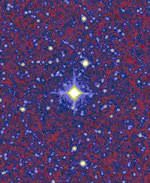
Image credit: NASA
A team of European astronomers announced this week that they have discovered seven new planets, bringing the total of extrasolar planets discovered to 115. Six of the planets circle stars that weren’t previously known to contain planets. All are gas giants, ranging in size from slightly smaller than Jupiter up to eight times the mass of Jupiter. They were detected using the radial velocity method, where astronomers watch for back and forth movement of a star caused by interaction with its planet. There are currently 30 teams searching for planets around other stars.
European astronomers this week announced the discovery of seven new planets orbiting other stars, bringing to 115 the total number of known extrasolar planets. Six of the new planets circle stars not previously known to harbor planets, while the seventh orbits a star where another planet had been detected earlier.
All of the new planets are gas giants, ranging in size from slightly smaller than Jupiter to nearly eight-times the mass of Jupiter. They were detected using the radial velocity method, which infers the presence of an unseen companion because of the back-and-forth movement it induces in the host star. This movement is detectable as a periodic red shift and blue shift in the star’s spectral lines. (For more about this method, see the article Finding Planets.)
A team led by Michel Mayor, as part of the ongoing Geneva Extrasolar Planet Search program, was responsible for six of the new discoveries: HD 65216, HD111232, HD142415, HD216770, HD10647 and HD 169830. In 1995, Mayor was co-discoverer, along with Didier Queloz, of 51 Pegasi, the first known planet around another star.
Additionally, Japanese astronomers last week announced the discovery of a new planet around a giant star (also using radial velocity). This new planet, HD 104985 b, is more than six time the mass of Jupiter. It was the first to be discovered by a Japanese planet-search team, according the Extrasolar Planets Encyclopedia.
There are currently more than 30 planet-search programs under way worldwide using ground-based telescopes. While none of the planets detected thus far is believed to have the potential to support life, NASA is developing a suite of space-based missions that will be capable of detecting for smaller, habitable planets within the next decade. See the links at left under “Missions” for information on NASA’s planet-finding missions, which include the Space Interferometery Mission, Kepler and Terrestrial Planet Finder.
Original Source: NASA News Release
